
The following is a list of dukes of Braganza, one of the most important noble titles, and later royal title, in the Kingdom of Portugal.

The following is a list of dukes of Braganza, one of the most important noble titles, and later royal title, in the Kingdom of Portugal.
Note: The blue shade means that the person was not officially created Duke of Braganza, the person only claimed the title.
| Name | Picture | Birth | Claimed title | Ceased to be Duke | Death | Other titles claimed | Marriages |
|---|---|---|---|---|---|---|---|
| Miguel Januário of Braganza | 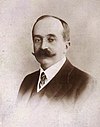 | 19 September 1853 eldest son of King Miguel I of Portugal | 4 October 1910 or 14 November 1866 | 31 July 1920 | 11 October 1927 | Duke of Barcelos, Marquis of Vila Viçosa, Count of Barcelos, Count of Ourém, Count of Arraiolos, Count of Neiva | Princess Elisabeth of Thurn and Taxis Princess Maria Theresa of Löwenstein-Wertheim-Rosenberg |
| Duarte Nuno of Braganza | 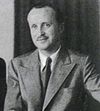 | 23 September 1907 3rd son of Miguel | 31 July 1920 or 2 July 1932 | 24 December 1976 | Duke of Barcelos, Marquis of Vila Viçosa, Count of Barcelos, Count of Ourém, Count of Arraiolos, Count of Neiva | Princess Francisca of Orléans-Braganza | |
| Duarte Pio of Braganza |  | 15 May 1945 eldest son of Duarte Nuno | 24 December 1976 | Incumbent | Living | Prince of Beira, Duke of Barcelos, Duke of Guimarães, Marquis of Vila Viçosa, Count of Barcelos, Count of Ourém, Count of Arraiolos, Count of Neiva | Isabel de Herédia |
The Miguelist heir apparent, claiming the title of Prince of Beira, is Afonso de Santa Maria (b. 1996).
| Name | Picture | Birth | Claimed title | Ceased to be Duke | Death | Other titles claimed | Marriages |
|---|---|---|---|---|---|---|---|
| Maria Pia of Braganza |  | 13 March 1907 as claimed illegitimate daughter of King Carlos I of Portugal | 2 July 1932 | 23 April 1987 | 6 May 1995 | Duchess of Porto, Duchess of Beja, Duchess of Coimbra, Countess of Neiva, Countess of Arraiolos, Countess of Penafiel | Francesco Batista General Giuseppe Blais António Amado-Noivo |

The title Duke of Braganza in the House of Braganza is one of the most important titles in the peerage of Portugal. Starting in 1640, when the House of Braganza acceded to the throne of Portugal, the male heir of the Portuguese Crown were known as Duke of Braganza, along with their style Prince of Beira or Prince of Brazil. The tradition of the heir to the throne being titled Duke of Braganza was revived by various pretenders after the establishment of the Portuguese Republic on 5 October 1910 to signify their claims to the throne.

The Most Serene House of Braganza, also known as the Brigantine dynasty, is a dynasty of emperors, kings, princes, and dukes of Portuguese origin which reigned in Europe and the Americas.

The Duchy of Braganza has been the fief of an important Portuguese noble family: the House of Braganza, and is one of the most important Dukedoms of Portugal. Created in 1442 by King Afonso V of Portugal for his uncle Afonso, Count of Barcelos, it is one of the oldest fiefdoms in Portugal.

Vila Viçosa is a town and a municipality in the District of Évora, Alentejo in Portugal. The population in 2011 was 8,319, in an area of 194.86 km².
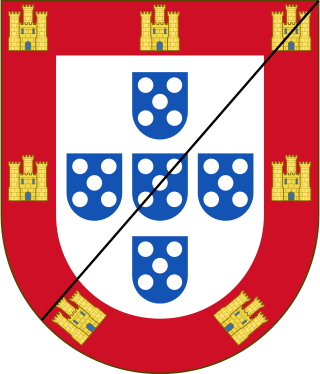
Duke of Aveiro was a Portuguese title of nobility, granted in 1535 by King John III of Portugal to his 4th cousin, John of Lencastre, son of Infante George of Lencastre, a natural son of King John II of Portugal.
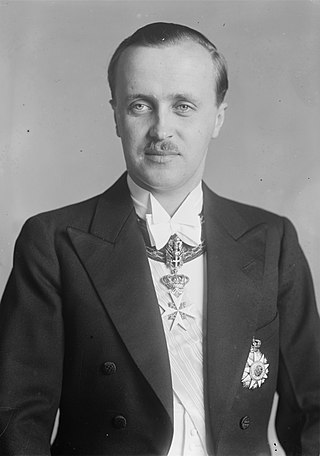
DomDuarte Nuno, Duke of Braganza was the claimant to the defunct Portuguese throne, as both the Miguelist successor of his father, Miguel Januário, Duke of Braganza, and later as the head of the only Brigantine house, after the death of the last ruling Braganza, King Manuel II of Portugal. In 1952, when the Portuguese Laws of Banishment were repealed, the Duke moved his family to Portugal, thus returning the Miguelist Braganzas to their homeland and becoming the first of the former Portuguese royal dynasty to live in Portugal since the abolition of the monarchy in 1910.
The highest hereditary title in the Portuguese nobility. By tradition, there are a total of five royal and seven non-royal dukes in Portugal, out of 28 dukedoms that have ever been created. In the majority of cases, the title of duke was attributed to members of the high nobility, usually relatives of the Portuguese royal family, such as the second son of a monarch.

Duke of Loulé is a Portuguese title of nobility created by a royal decree of King Luis I of Portugal, dated from October 3, 1862, to his grand-uncle Nuno José Severo de Mendoça Rolim de Moura Barreto, 2nd Marquis of Loulé and 9th Count of Vale de Reis. The new duke descended from earlier Portuguese monarchs and belonged to the highest nobility. After the fall of the monarchy in 1910 and the death of King Manuel II, the Duke of Loulé was acclaimed by his supporters as head of the Portuguese Royal house.
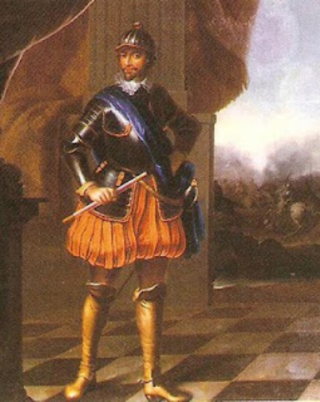
Dom Fernando II of Braganza was the 3rd Duke of Braganza and the 1st Duke of Guimarães, among other titles. He is known for being executed for treason against the King.

Duke of Viseu was a Portuguese Royal Dukedom created in 1415 by King John I of Portugal for his third male child, Henry the Navigator, following the conquest of Ceuta.

Jaime of Braganza was the 4th Duke of Braganza and the 2nd Duke of Guimarães, among other titles. He is known for reviving the wealth and power of the House of Braganza which had been confiscated by King John II of Portugal.

Duke of Lafões is a Portuguese title of nobility created under the decree of February 17, 1718, of King John V of Portugal and granted to his nephew, Dom Pedro Henrique de Bragança, the building force behind Palacio do Grilo and first son of Infante Miguel de Bragança, the latter an illegitimate son of King Peter II of Portugal and Anne Armande Pastre de Verger. Pedro's mother, Luisa Casimira de Sousa Nassau e Ligne was the first to use this title. The title was later passed on to his brother, João Carlos de Bragança e Ligne de Sousa Tavares Mascarenhas da Silva, the most famous Duke of this title.

Count of Barcelos is a title of nobility, the first to be granted in Portugal. It was created in 1298 by king Denis I and initially it was a non hereditary title, although most of the holders belonged to the Teles de Menezes family. It was only after the death of the 6th Count, when it was granted to Nuno Álvares Pereira, that the title became hereditary. The 8th Count of Barcelos was created Duke of Braganza in 1442, by his nephew king Afonso V, and his descendants rose to the Portuguese throne after the country regained its independence from Spain in 1640.

Duke of Coimbra was an aristocratic Portuguese title with the level of royal dukedom, that is, associated with the Portuguese royal house, created in 1415, by King John I of Portugal to his 2nd male son, Infante Pedro. Pedro was regent of the kingdom but he was killed in the domestic Battle of Alfarrobeira (1449).

Duke of Cadaval is a title of Portuguese nobility. It was created on 26 April 1648 by King John IV of Portugal for his distant cousin, Dom Nuno Álvares Pereira de Melo (1638–1725), who was already 4th Marquis of Ferreira and 5th Count of Tentúgal.
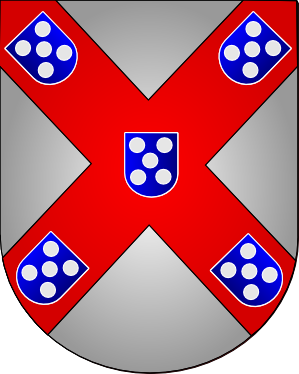
The Dukes of Barcelos was a title of nobility granted by King Sebastian of Portugal on 5 August 1562 to the heir of the Duke of Braganza. After the Braganza accession to the throne, the title continued to be the title of the heir of the Duke of Braganza, alongside the title of Prince of Beira.

Duke of Guimarães was a Nobility title granted by King Afonso V of Portugal in 1475, to Ferdinand II, 3rd Duke of Braganza. The king just upgraded the previous title of count of Guimarães, that he granted to the same Duke of Braganza, some years before.

The Portuguese nobility was a social class enshrined in the laws of the Kingdom of Portugal with specific privileges, prerogatives, obligations and regulations. The nobility ranked immediately after royalty and was itself subdivided into a number of subcategories which included the titled nobility and nobility of blood at the top and civic nobility at the bottom, encompassing a small, but not insignificant proportion of Portugal's citizenry.
The Ducal Palace of Vila Viçosa is a royal palace in Portugal, located in the civil parish of Nossa Senhora da Conceição, in the municipality of Vila Viçosa, in the Alentejo, situated about 150 km east of the capital Lisbon. It was for many centuries the seat of the House of Braganza, one of the most important noble houses in Portugal. Braganza was the ruling house of the Kingdom of Portugal from 1640 until 1910, when King Manuel II, titular head of the family, was deposed in the 5 October 1910 Revolution which brought in a Republican government.